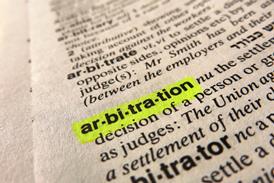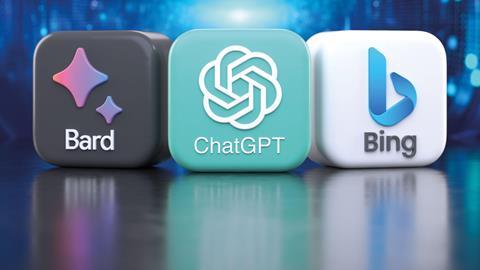Adapt or fall behind
Lawyers need to understand how to work with artificial intelligence (AI). Many clients I work with already have access to generative AI functionality akin to ChatGPT; but inside their organisation, where the solution can be used without concerns about confidentiality of data. With the imminent rollout of Microsoft AI Copilot across all the Office applications (including Outlook and Word) and other AI-for-the-enterprise solutions, all lawyers will soon have the ability to easily use AI for their work. It will be a differentiator. Lawyers will not lose their jobs or clients to AI, but they will lose them to other lawyers using AI.

The speed of AI development in recent months has been faster than anything the tech sector has seen – even eclipsing Moore’s Law [that the number of transistors in an integrated circuit doubles about every two years]. So fast, indeed, that a new term has been coined: AI is said to be growing at a ‘stacked algorithmic’ pace. This speed has been made possible because, for the first time ever, the new technology is building off its own insights. It is as profound a technological development as the personal computer and the smartphone.
Legal tech, or technology designed to streamline and enhance legal services, has been around for decades. However, despite its transformative potential, it has not made a significant impact on the traditional practice of law. Indeed, the intersection of law and technology has been a gradual process, marked by caution and measured adoption.
The most successful legal tech solutions so far have been those that focus on specific, often labour-intensive tasks such as eDiscovery, content management, practice management, eBilling, and contract lifecycle management. These technologies have been adopted successfully, automating repetitive tasks and reducing manual labour. Overall, however, the practice of law has continued largely without radical transformation.
Despite concerns and discussions around automation leading to job losses, the legal recruitment market has remained robust. The employment rate for lawyers has, interestingly, grown more quickly than the general employment rate. This points to the fact that while technology is evolving and reshaping certain aspects of the profession, it has not displaced the need for human expertise.
Nevertheless, the advent of AI presents a new frontier with the potential to truly transform, and potentially disrupt, the practice of law, both in-house and in private practice. AI extends beyond the automation of simple tasks. Its power lies in its ability to analyse vast amounts of data, learn from it, and make predictions or decisions based on that learning. This opens up a whole new array of applications that can augment the capabilities of lawyers and reshape the legal landscape.
It is, therefore, critical for all lawyers to understand AI and, more importantly, to learn to work alongside it. Just as we have grown accustomed to using email and mobile phones in our professional lives, AI must also become an integral tool in our legal toolkit. The failure to engage with AI might lead to inefficiency, a lack of competitiveness, and potential issues in adapting to the rapidly evolving legal environment.
Generative AI and legal services
Generative AI refers to a subset of AI focused on creating new content. It involves algorithms capable of producing data that closely mimics input data. Common forms of generative AI include generative pretrained transformers (GPTs) and generative adversarial networks (GANs). These generate, respectively, realistic text and images.
One prominent example is ChatGPT-4, a language model developed by OpenAI capable of generating human-like text based on the context provided to it. This AI algorithm learns the patterns, structures or characteristics of the input data, and then generates new, unique data that retains these learned traits. Microsoft is in an investor in OpenAI and consequently there is now AI capability on Bing Chat. Microsoft will soon release an AI copilot for the Office suite, including Word and Outlook. Other generative AI text tools include Google Bard and Github Copilot for developers. As mentioned, the technology is not limited to text. For example, there are generative AI tools which create new images such as Midjourney, DALL-E 2 and Stable Diffusion. There are new specific use-cases platforms for this technology being released almost every week. Specific generative AI solutions targeted at the legal sector include Harvey and Robin, as well as generative AI-enhancements to existing solutions from Casetext and Ironclad.
Generative AI holds tremendous potential for the legal sector, with possible applications including:
1. Contract generation: generative AI can draft new contracts based on specific parameters provided by a user, reducing time spent on contract drafting. Lawyers are already going to ChatGPT for template documents, though the quality is variable.
2. Legal drafting: initial drafts of legal advice or other legal writing can be generated by AI. These drafts can then be fine-tuned by the lawyer.
3. Summarisation: AI is very good at generating concise summaries of whatever is put into it. This could be summarising legal documents, such as in a due diligence exercise, or summarising lengthy court cases, aiding quick comprehension of key case points.
4. Predictive analysis: generative AI can predict case outcomes based on historical legal data, informing legal decision-making.
5. Legal research: AI can assist in legal research by generating contextually relevant questions and answers, increasing research efficiency.
6. Drafting marketing and social media content: generative AI can automate the creation of engaging legal marketing and social media content, enhancing online visibility and client engagement.
7. Drafting submissions to governments on proposed legislation: AI can generate initial drafts of submissions to government agencies commenting on proposed legislation, saving significant time and effort. One of the great powers of AI is that it is very good at ‘tone’ and can adjust this to be more compelling, less assertive and so on.
8. Drafting policy documents: AI can assist in creating first drafts of company policy documents such as ESG policies, privacy policies, or niche policies such as cryptography policies.
9. Analysis: generative AI can be used to conduct analyses, like a SWOT analysis of your business or an analysis of a lawyer’s public profile, providing valuable insights for strategic planning.
10. Creating standard process templates: generative AI can create standard legal templates, such as initial letters of demand for a debt, follow-up letters, and final letters, streamlining repetitive legal processes.
I have clients who are using generative AI for these applications. It is important for all lawyers to become familiar with AI and how it can help make them better at what they do.
Nick Abrahams is global co-leader, digital transformation practice, at Norton Rose Fulbright, and co-founder of online legal service LawPath. Abrahams is a professor at Bond University, where he teaches The Breakthrough Lawyer, an online coaching programme designed to help lawyers grow as legal leaders and innovators that will be available to UK lawyers in 2024. This article is the first in a three-part series






























No comments yet